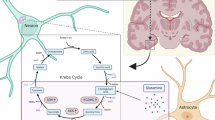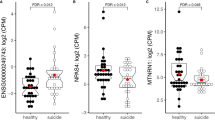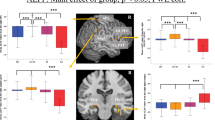Abstract
Phosphoinositide 3 (PI 3)-kinase is one of the key signaling enzymes that participates in a myriad of physiological functions in brain and is utilized by neurotrophins to mediate neuronal plasticity, cell survival, and inhibition of apoptosis for several neuronal subtypes. Our recent demonstration that expression of neurotrophic factors and activation of the receptor tyrosine kinase B are significantly altered in postmortem brain of suicide subjects led us to examine whether suicide brain is associated with alterations in PI 3-kinase signaling. In prefrontal cortex (PFC), hippocampus, and cerebellum of suicide (n=28) and nonpsychiatric control (n=21) subjects we examined catalytic activation of PI 3-kinase, and mRNA and protein levels of regulatory (p85α, p85β) and catalytic (p110α, p110β) subunits of PI 3-kinase. It was observed that the catalytic activity of PI 3-kinase was significantly reduced in PFC and hippocampus of suicide subjects compared with nonpsychiatric control subjects. Competitive PCR analysis revealed significantly reduced mRNA expression of p85β and p110α and increased expression of p85α subunit isoforms in PFC and hippocampus of suicide subjects. Alterations in these catalytic and regulatory subunits were accompanied by changes in their respective protein levels. These changes were not present in cerebellum of suicide subjects. Also, these changes were present in all suicide subjects irrespective of psychiatric diagnosis. Our findings of reduced activation and altered expression of specific PI 3-kinase regulatory and catalytic subunit isoforms demonstrate abnormalities in this signaling pathway in postmortem brain of suicide subjects and suggest possible involvement of aberrant PI 3-kinase signaling in the pathogenic mechanisms of suicide.
Similar content being viewed by others
Log in or create a free account to read this content
Gain free access to this article, as well as selected content from this journal and more on nature.com
or
References
Alessi DR, Deak M, Casamayor A, Caudwell FB, Morrice N, Norman DG et al (1997). 3-Phosphoinositide-dependent protein kinase-1 (PDK1): structural and functional homology with the Drosophila DSTPK61 kinase. Curr Biol 7: 776–789.
Altar CA, Laeng P, Jurata LW, Brockman JA, Lemire A, Bullard L et al (2004). Electroconvulsive seizures regulate gene expression of distinct neurotrophic signaling pathways. J Neurosci 24: 2277–2677.
Altschuler DL, Casanova MF, Goldberg TE, Kleinman JE (1990). The hippocampus and parahippocampus in schizophrenia, suicide and control brains. Arch Gen Psychiatry 47: 1029–1034.
Antonetti DA, Algenstaedt P, Kahn CR (1996). Insulin receptor substrate 1 binds two novel splice variants of the regulatory subunit of phosphatidylinositol 3-kinase in muscle and brain. Mol Cell Biol 16: 2195–2203.
Benes FM, Kwok EW, Vincent SL, Todtankopf MS (1998). A reduction of nonpyramidal cells in sector CA2 of schizophrenics and manic depressives. Biol Psychiatry 15: 88–97.
Bondeva T, Pirola L, Bulgarelli-Leva G, Rubio I, Wetzker R, Wymann MP (1998). Bifurcation of lipid and protein kinase signals of PI3Kgamma to the protein kinases PKB and MAPK. Science 282: 293–296.
Bremner JD, Narayan M, Anderson ER, Stalb LH, Miller HL, Charney DS (2000). Hippocampal volume reduction in major depression. Am J Psychiatry 48: 971–975.
Cantley LC (2002). The phosphoinositide 3-kinase pathway. Science 296: 1655–1657.
Carpenter CL, Auger KR, Duckworth BC, Hou WM, Schaffhausen B, Cantley LC (1993). A tightly associated serine/threonine protein kinase regulates phosphoinositide 3-kinase activity. Mol Cell Biol 13: 1657–1665.
Chalecka-Franaszek E, Chuang DM (1999). Lithium activates the serine/threonine kinase Akt-1 and suppresses glutamate-induced inhibition of Akt-1 activity in neurons. Proc Natl Acad Sci USA 96: 8745–8750.
Chou MM, Hou W, Johnson J, Graham LK, Lee MH, Chen CS et al (1998). Regulation of protein kinase C zeta by PI 3-kinase and PDK-1. Curr Biol 8: 1069–1077.
Clayton PJ (1985). Suicide. Psychiatr Clin North Am 8: 203–214.
Crowder RJ, Freeman RS (1998). Phosphatidylinositol 3-kinase and Akt protein kinase are necessary and sufficient for the survival of nerve growth factor-dependent sympathetic neurons. J Neurosci 18: 2933–2943.
Datta SR, Dudek H, Tao X, Masters S, Fu H, Gotoh Y et al (2000). Akt phosphorylation of BAD couples survival signals to the cell-intrinsic death machinery. Cell 91: 231–241.
Dhand R, Hiles I, Panayotou G, Roche S, Fry MJ, Gout I et al (1994). PI 3-kinase is a dual specificity enzyme: autoregulation by an intrinsic protein-serine kinase activity. EMBO J 13: 522–533.
Dijkhuizen PA, Ghosh A (2005). Regulation of dendritic growth by calcium and neurotrophin signaling. Prog Brain Res 147: 17–27.
Dolcet X, Egea J, Soler RM, Martin-Zanca D, Comella JX (1999). Activation of phosphatidylinositol 3-kinase, but not extracellular-regulated kinases, is necessary to mediate brain-derived neurotrophic factor-induced motoneuron survival. J Neurochem 73: 521–531.
Downes CP, Gray A, Lucocq JM (2005). Probing phosphoinositide functions in signaling and membrane trafficking. Trends Cell Biol 15: 259–268.
Downward J (2004). PI 3-kinase, Akt and cell survival. Semin Cell Dev Biol 15: 177–182.
Drevets WC, Gadde KM, Krishman KR (1999). Neuroimaging studies of mood disorders. In: Charney DS, Nestler EJ, Bunney BS (eds). Neurobiology of Mental Illness. Oxford University Press: New York, pp 394–418.
Drevets WC, Price JL, Simpson Jr JR, Todd RD, Reich T, Vannier M et al (1997). Subgenual prefrontal cortex abnormalities in mood disorders. Nature 386: 824–827.
Duman RS (2002). Pathophysiology of depression: the concept of synaptic plasticity. Eur Psychiatry 17: 306–310.
Dwivedi Y, Conley RR, Roberts RC, Tamminga CA, Pandey GN (2002). Alpha subunits of G proteins in the prefrontal cortex of teenage and adult suicide victims. Neuropsychopharmacology 27: 499–517.
Dwivedi Y, Mondal AC, Rizavi HS, Conley RR (2005a). Suicide brain is associated with decreased expression of neurotrophins. Biol Psychiatry 58: 315–324.
Dwivedi Y, Mondal AC, Rizavi HS, Shukla PK, Pandey GN (2005b). Single and repeated stress-induced modulation of phospholipase C catalytic activity and expression: role in LH behavior. Neuropsychopharmacology 30: 473–483.
Dwivedi Y, Rao JS, Rizavi HS, Kotawski J, Conley RR, Roberts RC et al (2003b). Abnormal expression and functional characteristics of cyclic adenosine monophosphate response element binding protein in postmortem brain of suicide subjects. Arch Gen Psychiatry 60: 273–282.
Dwivedi Y, Rizavi HS, Conley RR, Pandey GN (2006). ERK MAP kinase signaling in post-mortem brain of suicide subjects: differential regulation of upstream Raf kinases Raf-1 and B-Raf. Mol Psychiatry 11: 86–98.
Dwivedi Y, Rizavi HS, Conley RR, Roberts RC, Tamminga CA, Pandey GN (2003a). Altered gene expression of brain-derived neurotrophic factor and receptor tyrosine kinase B in postmortem brain of suicide subjects. Arch Gen Psychiatry 60: 804–815.
Dwivedi Y, Rizavi HS, Roberts RC, Conley RC, Tamminga CA, Pandey GN (2001). Reduced activation and expression of ERK1/2 MAP kinase in the post-mortem brain of depressed suicide subjects. J Neurochem 77: 916–928.
Engelman JA, Luo J, Cantley LC (2006). The evolution of phosphatidylinositol 3-kinase as regulators of growth and metabolism. Nature 7: 606–619.
Falasca M, Logan S, Lehto VP, Baccante G, Lemmon MA, Schlessinger J (1998). Activation of phospholipase C gamma by PI 3-kinase-induced PH domain-mediated membrane targeting. EMBO J 17: 414–422.
Fossati P, Radtchenko A, Boyer P (2004). Neuroplasticity: from MRI to depressive symptoms. Eur Neuropsychopharmacol 14: S503–S510.
Fruman DA, Cantley LC, Carpenter CL (1996). Structural organization and alternative splicing of the murine phosphoinositide 3-kinase p85á gene. Genomics 37: 113–121.
Fruman DA, Meyers RE, Cantley LC (1998). Phosphoinositide kinases. Annu Rev Biochem 67: 481–507.
George MS, Ketter TA, Post RM (1994). Prefrontal cortex dysfunction in clinical depression. Depression 2: 59–72.
Giorgino F, Pedrini MT, Matera L, Smith RJ (1997). Specific increase in p85á expression in response to dexamethasone is associated with inhibition of insulin-like growth factor-1 stimulated phosphatidylinositol 3-kinase activity in cultured muscle cells. J Biol Chem 272: 7455–7463.
Harrison PJ, Heath PR, Eastwood SL, Burnet PW, McDonald B, Pearson RC (1995). The relative importance of premortem acidosis and postmortem interval for human brain gene expression studies: selective mRNA vulnerability and comparison with their encoded proteins. Neurosci Lett 200: 151–154.
Hawkins PT, Jackson TR, Stephens LR (1992). Platelet-derived growth factor stimulates synthesis of PtdIns(3,4,5)P3 by activating a PtdIns(4,5)P2 3-OH kinase. Nature 358: 157–159.
Hetman M, Kanning K, Cavanaugh JE, Xia Z (1999). Neuroprotection by brain-derived neurotrophic factor is mediated by extracellular signal-regulated kinase and phosphatidylinositol 3-kinase. J Biol Chem 274: 22569–22580.
Hiles ID, Otsu M, Volinia S, Fry MJ, Gout I, Dhand R et al (1992). Phosphatidylinositol 3-kinase: structure and expression of the 110 kDa catalytic subunit. Cell 70: 419–429.
Horsch D, Kahn CR (1999). Region-specific mRNA expression of phosphatidylinositol 3-kinase regulatory isoforms in the central nervous system of C57BL/6J mice. J Comp Neurol 415: 105–120.
Hsiung SC, Adlersberg M, Arango V, Mann JJ, Tamir H, Liu KP (2003). Attenuated 5-HT1A receptor signaling in brains of suicide victims: involvement of adenylyl cyclase, phosphatidylinositol 3-kinase, Akt and mitogen-activated protein kinase. J Neurochem 87: 182–194.
Hu P, Mondino A, Skolnik EY, Schlessinger J (1993). Cloning of a novel, ubiquitously expressed human phosphatidylinositol 3-kinase and identification of its binding site on p85. Mol Cell Biol 13: 7677–7688.
Hu QJ, Klippel A, Muslin AJ, Fantl WJ, Williams LT (1995). Ras-dependent induction of cellular-responses by constitutively active phosphatidylinositol-3 kinase. Science 268: 100–102.
Inukai K, Funaki M, Ogihara T, Katagiri H, Kanda A, Anai M et al (1997). p85á gene generates three isoforms of regulatory subunit for phosphatidylinositol 3-kinase (PI3-kinase), p50á, p55á, and p85á, with different PI 3-kinase activity elevating responses to insulin. J Biol Chem 272: 7873–7882.
Kaplan D, Miller F (2001). Neurotrophin signal transduction in the nervous system. Curr Opin Neurobiol 10: 381–391.
Kolomeets NS, Orlovskaya DD, Rachmanova VI, Uranova NA (2005). Ultrastructural alterations in hippocampal mossy fiber synapses in schizophrenia: a postmortem morphometric study. Synapse 57: 47–55.
Le Good JA, Ziegler WH, Parekh DB, Alessi DR, Cohen P, Parker PJ (1998). Protein kinase C isotypes controlled by phosphoinositide 3-kinase through the protein kinase PDK1. Science 281: 2042–2045.
Leemhuis J, Mayer U, Barth H, Schmidt G, Meyer DK (2004). The small GTPase Rac is involved in clustering of hippocampal neurons and fasciculation of their neurites. Arch Pharmacol 370: 211–222.
Lin CH, Yeh SH, Lin CH, Lu KT, Leu TH, Chang WC et al (2001). A role for the PI-3 kinase signaling pathway in fear conditioning and synaptic plasticity in the amygdala. Neuron 31: 841–851.
Liot G, Gabriel C, Cacquevel M, Ali C, MacKenzie ET, Buisson A et al (2004). Neurotrophin-3-induced PI-3 kinase/Akt signaling rescues cortical neurons from apoptosis. Exp Neurol 187: 38–46.
Lowry OH, Rosebrough NJ, Farr AL, Randall RJ (1951). Protein measurement with the folic phenol reagent. J Biol Chem 193: 266–275.
Mann JJ, Currier D (2007). A review of prospective studies of biologic predictors of suicidal behavior in mood disorders. Arch Suicide Res 11: 3–16.
Martin-Pena A, Acebes A, Rodriguez J-R, Sorribes A, Depolavieja GG, Fernandez-Funez P et al (2006). Age-independent synaptogenesis by phosphoinositide 3 kinase. J Neurosci 26: 10199–10208.
Miller F, Kaplan D (2001). Neurotrophin signal pathways regulating neuronal apoptosis. Cell Mol Life Sci 58: 1045–1053.
Monk M (1987). Epidemiology of suicide. Epidemiol Rev 9: 51–69.
Okkenhaug K, Vanhaesebroeck B (2001). New responsibilities for the PI3K regulatory subunit p85 alpha. Sci STKE 65: PE1.
Ou L-C, Gean P-W (2006). Regulation of amygdala-dependent learning by brain-derived neurotrophic factor is mediated by extracellular signal-regulated kinase and phosphatidylinositol-3-kinase. Neuropsychopharmacology 31: 287–296.
Pandey GN, Dwivedi Y, Rizavi HS, Ren X, Conley RR (2004). Decreased catalytic activity and expression of protein kinase C isozymes in teenage suicide victims: a postmortem brain study. Arch Gen Psychiatry 61: 685–693.
Pandey SK, Theberge JF, Bernier M, Srivastava AK (1999). Phosphatidylinositol-3 kinase requirement in activation of the ras/C-raf-1/MEK/ERK and p70(s6k) signaling cascade by the insulinomimetic agent vanadyl sulfate. Biochemistry 38: 14,667–14,675.
Patapoutian A, Reichardt L (2001). Trk receptors: mediators of neurotrophin action. Curr Opin Neurobiol 11: 272–280.
Pons S, Asano T, Glasheen EM, Miralpeix M, Zhang Y, Fisher TL et al (1995). The structure and function of p55PIK reveal a new regulatory subunit for phosphatidylinositol 3-kinase. Mol Cell Biol 15: 4453–4465.
Rajkowska G (1997). Morphometric methods for studying the prefrontal cortex in suicide victims and psychiatric patients. Ann NY Acad Sci USA 836: 253–268.
Rajkowska G (2000). Postmortem studies in mood disorders indicate altered numbers of neurons and glial cells. Biol Psychiatry 48: 766–777.
Rajkowska G, Halaris A, Selemon LD (2001). Reductions in neuronal and glial density characterize the dorsolateral prefrontal cortex in bipolar disorder. Biol Psychiatry 49: 741–752.
Rajkowska G, Miguel-Hidalgo JJ, Wei J, Dilley G, Pittman SD, Meltzer HY et al (1999). Morphometric evidence for neuronal and glial prefrontal cell pathology in major depression. Biol Psychiatry 45: 1085–1098.
Rodgers EE, Theibert AB (2002). Functions of PI 3-kinase in development of the nervous system. Int J Dev Neurosci 20: 187–197.
Rodriquez-Viciana P, Warne PH, Dhand R, Vanhaesebroeck B, Gout I, Fry MJ et al (1994). Phosphatidylinositol-3-OH kinase as a direct target of Ras. Nature 370: 527–532.
Sala M, Perez J, Soloff P, Ucelli di Nemi S, Caverzasi E, Sores JC et al (2004). Stress and hippocampal abnormalities in psychiatric disorders. Eur Neuropsychopharmacol 14: 393–405.
Salzman S, Endicott J, Clayton P, Winokur G (1983). Diagnostic Evaluation After Death (DEAD). Neuroscience Research Branch, National Institute of Mental Health: Rockville, MD.
Sato S, Fujita N, Tsuruo T (2004). Involvement of 3-phosphatidylinositol-dependent protein kinase-1 in the MEK/MAPK signal transduction pathway. J Biol Chem 279: 33759–33767.
Segal RA (2003). Selectivity in neurotrophin signaling: theme and variations. Annu Rev Neurosci 26: 299–330.
Sheline YI, Warry P, Gado MH, Csernansky JC, Vannier MW (1996). Hippocampal atrophy in recurrent major depression. Proc Natl Acad Sci USA 93: 3908–3913.
Shin BC, Suzuki M, Inukai K, Anai M, Asano T, Takata K (1998). Multiple isoforms of the regulatory subunit for phosphatidylinositol 3-kinase (PI3-kinase) are expressed in neurons in the rat brain. Biochem Biophys Res Commun 246: 313–319.
Skaper SD, Floreani M, Negro A, Facci L, Giusti P (1998). Neurotrophins rescue cerebellar granule neurons from oxidative stress-mediated apoptotic death: selective involvement of phosphatidylinositol 3-kinase and the mitogen-activated protein kinase pathway. J Neurochem 70: 1859–1868.
Songyang Z, Shoelson SE, Chaudhuri M, Gish G, Pawson T, Haser WG et al (1993). SH2 domains recognize specific phosphopeptide sequences. Cell 72: 767–778.
Spitzer RL, Williams JBW, Gibbon M, First MD (1995). Structural Clinical Interview for DSM-IV (SCID),. New York State Psychiatric Institute Biometrics Research: New York, NY.
Sweatt JD (2004). Hippocampal function in cognition. Psychopharmacology 174: 99–110.
Ueki K, Fruman DA, Yballe CM, Fasshauer M, Klein J, Asano T et al (2003). Positive and negative roles of p85 alpha and p85 beta regulatory subunits of phosphoinositide 3-kinase in insulin signaling. J Biol Chem 278: 48453–48466.
Vanhaesebroeck B, Alessi DR (2000). The PI3K-PDK1 connection: more than just a road to PKB. Biochem J 346: 561–576.
Vanhaesebroeck B, Ali K, Bilancio A, Geering B, Foukas LC (2005). Signaling by PI3K isoforms: insights from gene-targeted mice. Trends Biochem Sci 30: 194–204.
Wymann MP, Zvelebil M, Laffargue M (2003). Phosphoinositide 3-kinase signaling—which way to target? Trends Pharmacol Sci 24: 366–376.
Yao R, Cooper GM (1995). Requirement for phosphatidylinositol 3-kinase and the prevention of apoptosis by nerve growth factor. Science 267: 2003–2006.
Zhou H, Li XM, Meinkoth J, Pittman RN (2000). Akt regulates cell survival and apoptosis at a post-mitochondrial level. J Cell Biol 151: 483–494.
Acknowledgements
This research was supported by NIMH R0168777, NARSAD, and the American Foundation for Suicide Prevention to Dr Dwivedi, NIMH RO1MH48153 to Dr Pandey, and NIMH R01MH60744 to Dr Roberts. We thank Prof. Robert Gibbons for his help analyzing data. We also thank Ms Miljana Petkovic and Ms Barbara Brown for their help in organizing the brain tissue, and members of the Maryland Brain Collection for their efforts, particularly in family interviews and dissection. We are grateful for the cooperation of the Office of the Chief Medical Examiner in Baltimore, MD, USA.
Author information
Authors and Affiliations
Corresponding author
Additional information
DISCLOSURE/CONFLICT OF INTEREST
The authors declare that, except for income received from the primary employer, no financial support or compensation has been received from any individual or corporate entity over the past 3 years for research or professional services and that there are no personal financial holdings that could be perceived as constituting a potential conflict of interest.
Rights and permissions
About this article
Cite this article
Dwivedi, Y., Rizavi, H., Teppen, T. et al. Lower Phosphoinositide 3-Kinase (PI 3-kinase) Activity and Differential Expression Levels of Selective Catalytic and Regulatory PI 3-Kinase Subunit Isoforms in Prefrontal Cortex and Hippocampus of Suicide Subjects. Neuropsychopharmacol 33, 2324–2340 (2008). https://doi.org/10.1038/sj.npp.1301641
Received:
Revised:
Accepted:
Published:
Issue date:
DOI: https://doi.org/10.1038/sj.npp.1301641
Keywords
This article is cited by
-
Antidepressant-like effect of guanosine involves activation of AMPA receptor and BDNF/TrkB signaling
Purinergic Signalling (2021)
-
Phosphoinositide-3-kinase regulatory subunit 1 gene polymorphisms are associated with schizophrenia and bipolar disorder in the Han Chinese population
Metabolic Brain Disease (2020)
-
Isoform-selective phosphoinositide 3-kinase inhibition ameliorates a broad range of fragile X syndrome-associated deficits in a mouse model
Neuropsychopharmacology (2019)
-
An overview of the neurobiology of suicidal behaviors as one meta-system
Molecular Psychiatry (2015)



